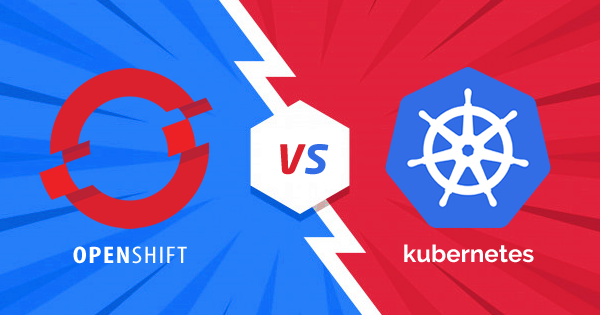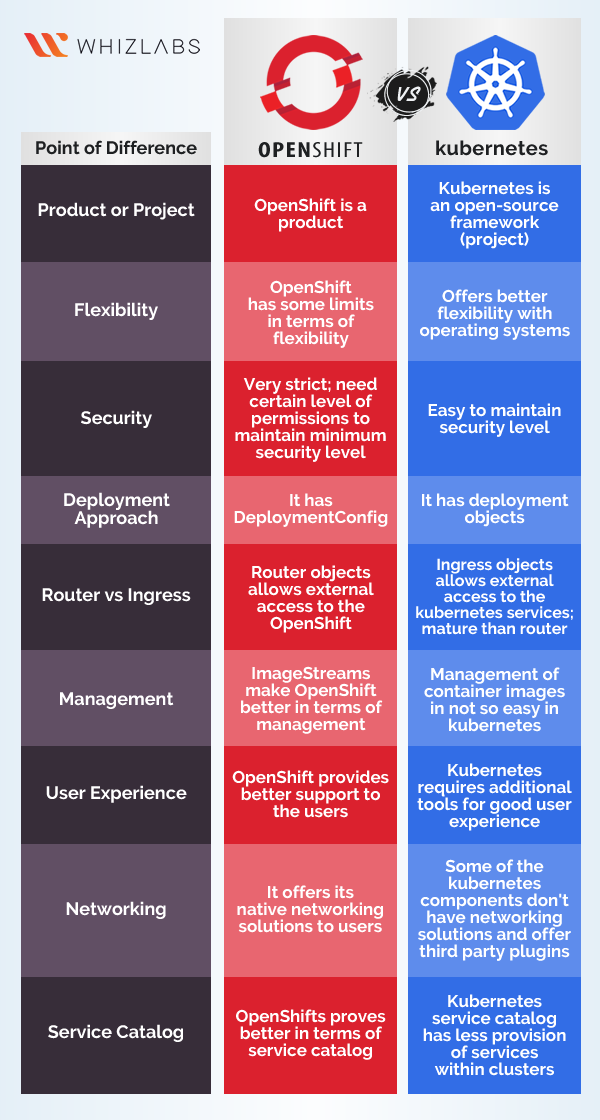Accelerating the pace of development is made possible with the use of deploying and developing apps. The use of containerization for these apps is on the rise in recent times. OpenShift and Kubernetes are popular platforms to make container management simple and easy. One can find a lot of similarities between the two because OpenShift is Kubernetes with some more additions. But still, there are a number of differences that we’ll discuss in this article i.e. OpenShift vs Kubernetes.
Kubernetes is an open-source system that helps in automating deployment, management, and scaling the containerized apps. On the other hand, OpenShift helps in the multi-tenant deployment and continuous development of applications. It adds the operation-centric and developer tools to the Kubernetes to make the rapid development of applications possible. The additions also assist in the easy scaling and deployment of apps.
Top 10 Differences between OpenShift and Kubernetes i.e. OpenShift vs Kubernetes
As mentioned above, there are a number of similarities between OpenShift and Kubernetes. But apart from these similarities, there are also some notable differences between the two. So, below are the top 10 differences between OpenShift and Kubernetes that you are required to be familiar with.
1. Product vs. Project
While searching for OpenShift vs Kubernetes, one of the major differences is that one is a product, and another is a project. While OpenShift is a popular product, Kubernetes is a framework or an open-source project. OpenShift allows the users to install the product that offers paid support with a subscription. The subscription is inclusive of CloudForms, which further helps in enhancing the features of the product. The users need to renew the subscriptions for their cluster, and the amount increases with the expansion of the cluster. An OpenShift tutorial can take you into the depth of the OpenShift concepts.
Kubernetes is a project that has a self-support model with several side projects, a community, and a whole ecosystem. It offers users the support of external experts and the community in problematic situations. However, it completely depends on the users whether they choose to use the project or prefer paying to avail the support and features of the product. To validate the skills as a Kubernetes administrator, one can choose to go for the Certified Kubernetes Administrator certification.
2. Flexibility
The running environment of Kubernetes and OpenShift differs. Users can find better flexibility of the Operating System with the Kubernetes. But the installation of OpenShift has its limits; Red Hat Enterprise Linux Atomic Host (RHELAH) and Red Hat Enterprise Linux (RHEL). The installation of OpenShift is also possible in CentOS as well as Fedora. Kubernetes doesn’t demand any specific requirements in terms of the operating system. Though deploying the Kubernetes requires some special skills and efforts, it is made possible with the latest cloud computing.
In terms of flexibility, Helm Charts of Kubernetes is more flexible than the templates of OpenShift. The usage of state-of-the-art templates and packages in the Helm chart is hard to deploy on the OpenShift. The Automation Broker or Service Catalog available on the OpenShift can be easily installed on Kubernetes. But Helm cannot find support on the OpenShift. This creates difficulty for the users to work with the inflexible templates of the former.
There are a number of myths associated with Kubernetes. Check out top Kubernetes Myths and Facts behind them.
3. Security
The security policies of OpenShift are stricter than the Kubernetes. The OpenShift platform forbids the running of most container images as well as many official images. It is easy for people to run simple apps on the Kubernetes, but the security policies of OpenShift restrict them to do so. A certain level of permissions is required to maintain the minimum security level, which can be provided by OpenShift. With the use of OpenShift, users do not have any choice but have to learn the policies to deploy more apps.
The areas of authentication and authorization can differentiate Kubernetes and OpenShift better. Although Kubernetes does not have login commands, they offer certain authentications that require effort for setup and configuration. On the other hand, OpenShift offers an integrated server for better authentication.
Authorization is offered by both the platforms through Role-Based Access Control (RBAC). In Kubernetes, Security contexts are a part of container specifications, but OpenShift has a separate Security Context Constraint (SCC). In the security aspect, undoubtedly the approach of OpenShift outweighs that of Kubernetes.
4. Deployment Approach
The approach towards deployment is another difference between OpenShift and Kubernetes. While Kubernetes have deployment objects, OpenShift has DeploymentConfig. The deployment objects are internally implemented by controllers and are used for updating pods.
On the other hand, the DeploymentConfig is not implemented by controllers but through dedicated pod logics. While dealing with multiple and concurrent updates, it is wise to choose deployment objects as DeploymentConfig does not support it. However, due to many advantages, people choose OpenShift DeploymenConfig over the Kubernetes deployment objects.
5. Router vs. Ingress
The Router objects in OpenShift and Ingress in Kubernetes almost perform similar kinds of jobs. Old and good HAproxy implements the router on OpenShift. But the Ingress on Kubernetes offers more choice as multiple different servers can easily implement it. Although the router lacks many features of Ingress, it is still considered to be more mature. The Kubernetes offer different enhancement options. In this aspect of Kubernetes vs OpenShift, though both perform great, the router outweighs Ingress due to its maturity aspect.
6. Management
ImageStreams of OpenShift makes the management of container images easy. This also makes the changing of tags for images in the container register simply. It allows downloading of whole images and changing them locally without the use of any external tools. With the ImageStream of OpenShift, users can upload the container images and manage the virtual tags conveniently.
With the use of ImageStream, users can hide image origins. OpenShift is the perfect choice for the deployment environment. In terms of management of OpenShift vs Kubernetes, the ImageStream of OpenShift stands out the best.
Read our previous article to know about top Kubernetes tips and tricks that will help you make Kubernetes usage easier.
7. User Experience
While considering OpenShift vs Kubernetes, user experience can be used to reflect the difference between OpenShift and Kubernetes better. Users still find it hard to learn and manage the containers due to the complex and cutting-edge interface. OpenShift offers support to the users for logging into the clusters. But with Kubernetes, users require external tools to obtain credentials and create files.
With OpenShift switching between projects or namespace is easy. But, here again, the Kubernetes require additional tools. In OpenShift, a single command user can build container images and use them in different environments. But it is difficult in the case of Kubernetes. Especially for beginners, OpenShift provides an excellent user experience. In regards to user experience, OpenShift proves to be better than Kubernetes.
8. Integrated CI/CD
The integrated Jenkins on the OpenShift did make the deployment of apps easy. It offers support for source to image helping the users to create custom-made Jenkins images that allow the easy update. The integrated Jenkins also makes management, upgrades, and testing easy. Synchronization becomes easy through this integration. In this aspect of OpenShift vs Kubernetes, OpenShift, with its additional feature, makes the deployment of apps easy with the CI/ CD pipelines.
9. Networking
Networking is another important point, which is important to consider in OpenShift vs Kubernetes. Kubernetes deals with network traffic in an abstract way. Though some components of Kubernetes do not have their native networking solutions, they offer third party plugins. With the use of these plugins, users can perform their different tasks.
But OpenShifts offers its native networking solution to the users. The OpenvSwitch of OpenShift is an out-of-the-box solution that has its architecture that offers the users three different plugins. The three plugins are OVS- subnet, OVS – multitenant, and OVS – network policy. Hence, OpenShift Kubernetes outweighs the Kubernetes in terms of networking.
10. Service Catalog
Service catalog forms another aspect of the difference between the two. In the case of Kubernetes, the service catalog forms an optional component that requires separate installation. After the completion of the installation, it again requires to get into contact with the existing service brokers. The service catalog provided by the Kubernetes has less provision for services within clusters. It has better provisions for managed services.
OpenShift Kubernetes offers a service catalog that has two default service brokers. It also allows the users to integrate another service broker for the managed services as in the case in Kubernetes. The service catalogs of OpenShift allow the comfortable deployment of selective applications by the users. In the difference, the latter proves to be better in terms of the service catalog.
Preparing for a Kubernetes interview? Here are the top Kubernetes interview questions with detailed answers that you should read to crack your Kubernetes interview.
Final Words
Since Kubernetes forms the base of OpenShift, one can find a lot of common aspects between the two. In OpenShift vs Kubernetes. The above mentioned are some of the significant differences available. While Kubernetes remains a container platform, OpenShift comes into being and keeps a tab on the needs of different enterprises. Through additions to Kubernetes, the existing infrastructure can evolve to the next phase. But it requires much effort and skills.
This makes OpenShift a better choice because of its built-in features. The manageable rollout, logging, and monitoring options keep OpenShift a step ahead of Kubernetes. The networking solutions, as well as the integrating and installing process, also account for OpenShift to be more demanding. Although both are quite similar, the out-of-the-box features of OpenShift make a big difference between OpenShift and Kubernetes.
To broaden your knowledge of OpenShift vs Kubernetes, you should work on both platforms. You can join our Kubernetes training course to know more about Kubernetes and OpenShift Basics Course to understand the foundation of OpenShift.
- Top 10 Highest Paying Cloud Certifications in 2024 - March 1, 2023
- 12 AWS Certifications – Which One Should I Choose? - February 22, 2023
- 11 Kubernetes Security Best Practices you should follow in 2024 - May 30, 2022
- How to run Kubernetes on AWS – A detailed Guide! - May 30, 2022
- Free questions on CompTIA Network+ (N10-008) Certification Exam - April 13, 2022
- 30 Free Questions on Microsoft Azure AI Fundamentals (AI-900) - March 25, 2022
- How to Integrate Jenkins with GitHub? - March 22, 2022
- How to Create CI/CD Pipeline Inside Jenkins ? - March 22, 2022







Good post and a comprehensive, balanced selection of content for the blog.
https://www.gologica.com/course/kubernetes-administrator-training/